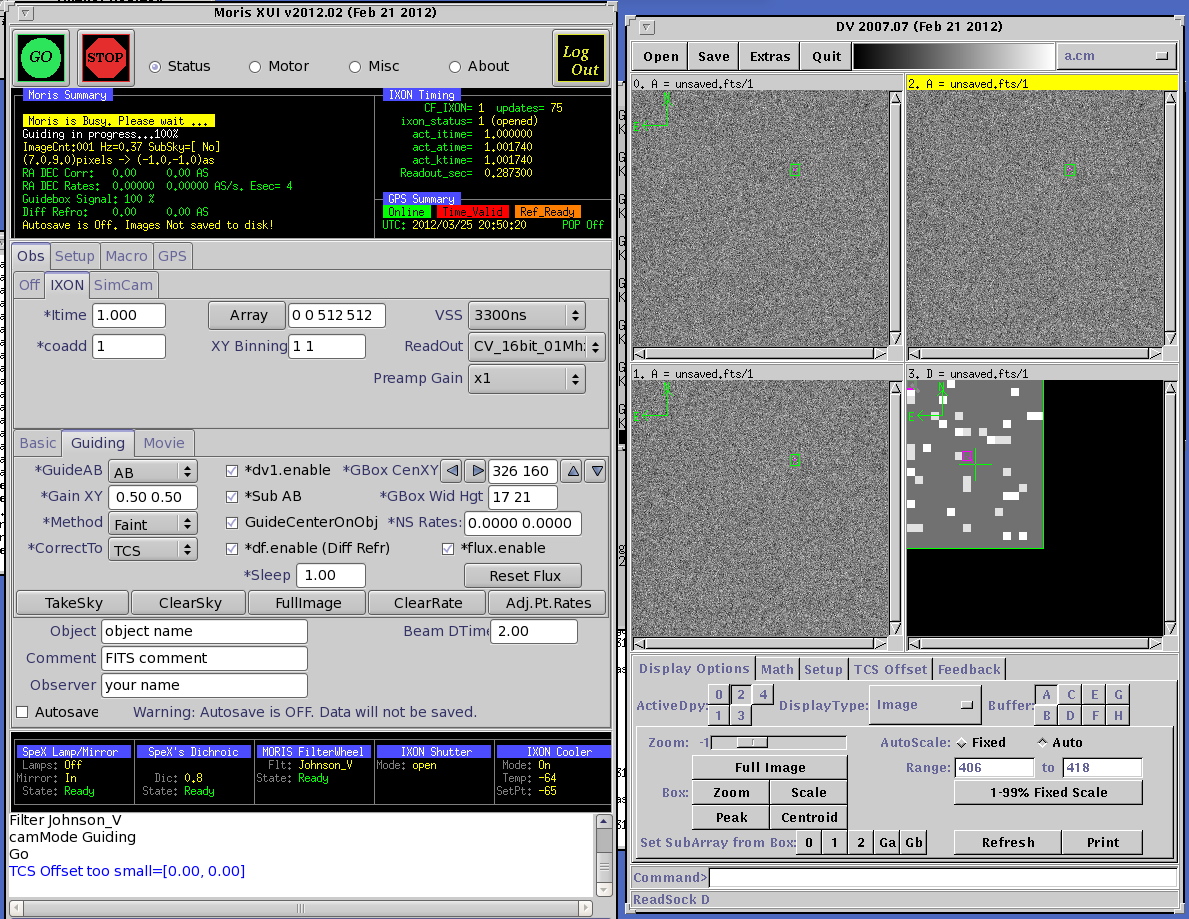Guiding can be done on spill-over flux from the object in the slit or on an object in the 60x60 arcsec field of the imager. In photometric conditions and in median seeing (0.7") the magnitude limit for auto-guiding on a star in the slit is about J=15; the magnitude limit for manual guiding (using the paddle) on a star in the slit is about J=18. The magnitude limit for auto-guiding on a star in the field is about J=18. These limits depend on seeing and slit width (no spillover in wide slits). Auto-guiding also works very well on extended objects such as galaxy nuclei and small disks (eg. 4 arcsec diameter Uranus) so long as the objects are bright enough and guiding on the peak or centroid is acceptable. Positioning a slit at a particular location on Jupiter or Saturn, for example, must be done using non-sidereal telescope tracking with manual updates provided by observing the slit location in the SpeX slit-viewer. For details read the document 'How to set up the IR guider'.
Visible guiding can be done using the off-axis guider. The location of the off-axis guide fields is shown below by the rectangular green boxes. The center of the boxes are located 244" east, 244" west, and 293" south of center. The dimesions of the individul guide fields are 100"x400", for a total off-axis field of about 30 sq. arcmin. The off-axis guider should be used as a last resort since there is some flexure between it and SpeX. However, it can be used for integrations of up to 30 minutes before recentering of the target in the slit is recommended. The off-axis guider does not compensate for differential atmospheric refraction due to guiding in the optical while observing in the NIR. However, visible guiding with MORIS does (see below).
Magnitude limit Itime (no moon) (sec) V=10.0 0.7 V=12.7 3.5 V=14.0 6.5 V=15.0 8.0 Place the science object in the slit and ask the telescope operator to start guiding on a suitable off-axis star. Make sure that the science object does not move out of the slit when guiding is started (it should not). Set up the telescope nod position as described in 'How to set up the the IR guider'.
Visible guiding can be done using MORIS. MORIS is a CCD system comprising
re-imaging optics, filter wheel, and cooled CCD. It is mounted on the
side of SpeX and is fed by a dicroic in SpeX. There is a choice of two
dichroics:
1) 0.80 micron cut-on which sends wavelengths < 0.80 micron
to the wavefront sensor (less light to guide on but
spectral coverage > 0.8 micron)
2) 0.95 micron cut-on which sends wavelengths < 0.95 micron
to the wavefront sensor (more light to guide on but
less spectral coverage > 0.95 micron)
The FOV of MORIS is about 80"x80".
Guiding with MORIS is designed to be very similar to using Guidedog with guide stars
in its FOV. Once the target is placed in the slit (beam A) draw a box around the guide
star in the MORIS FOV and select it in the MORIS DV display (click 'Ga'). Then start
'Guiding' with MORIS. It maybe necessary to nudge the target star as viewed in Guidedog
into the slit. This can be done either by moving the guide star with the paddle (the
guide box will move with ther star) or by incrementally abjusting the guide box
position with the arrows ('*GBOX CenXY'). The target can be nodded completely out of
the slit by selecting a different B beam position (click 'Gb'), otherwise the default
will be to nod within the slit.

A differential atmospheric refraction algorithm allow for accurate guiding in the NIR
while using an optical guide star. In photometric conditions and median seeing (0.7")
we have successfully guided with MORIS down to Sloan r'=20.4 and i'=19.9 using an
integration time of 15 sec.
For more information see the 'MORIS documentation'.
Back to the top
 Back to the main menu
Back to the main menu
